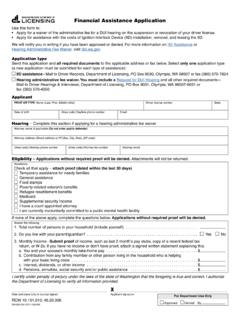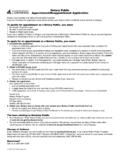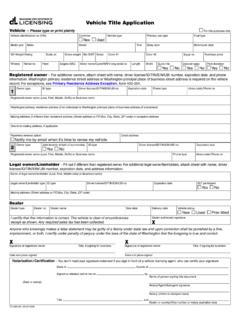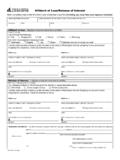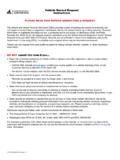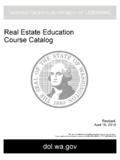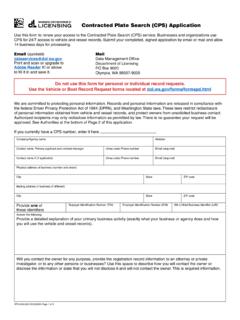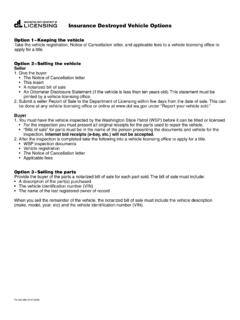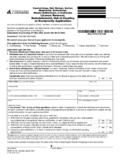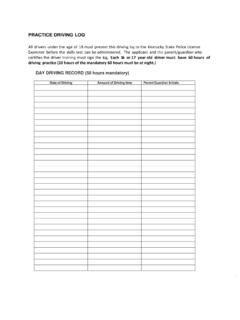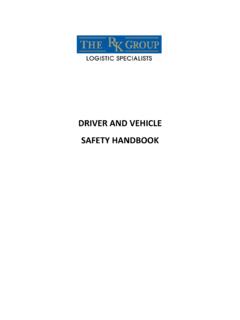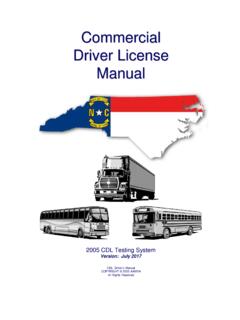Transcription of Driver Training: Required Curriculum - Wa
1 August 2018 Driver training : Required Curriculum Washington State Driver training Required Curriculum Page 1 August, 2018 Washington State Driver training Required Curriculum INTRODUCTION Young Driver fatalities are preventable tragedies, yet crashes continue to be the leading cause of death among our teens. There is an astounding disconnect between believing that teen driving is an endowed right, and the reality that when they are involved in a fatal collision, young drivers are at fault 75% of the time. The top three culprits are speeding, driving while impaired, and distracted driving all of which are the result of attitudes and behaviors.
2 Clearly, we need to make a significant change in the way we think about driving and the way we learn about who we are as drivers . One method for facilitating this change is through our Driver training program. In 2017, the Washington State legislature identified the need to establish consistency in the quality of Driver training education in our state to reduce the number of young Driver collisions. The Office Superintendent of Public Instruction (OSPI) and the Department of Licensing (DOL) were tasked with establishing and maintaining a Required Curriculum to support consistency among Driver training programs (RCWs and ).
3 This Required Curriculum is based on the Driving School Association of the Americas (DSAA) nationally recognized Curriculum standards, which meets the Novice Teen Driver Education and training Administrative Standards (NTDETAS), as well as the recommendations provided to Washington in the May 2016 Driver Education Program assessment by the National Highway Traffic Safety Administration (NHTSA). Each standard in our Required Curriculum is supportive of our State s Target Zero goals and guidelines. The Required Curriculum has been reviewed by the Washington Traffic Safety Commission as well as by a diverse group of Driver training professionals and stakeholders, and is written in a format that is: Student-Centered (focused on student, not teacher) Outcome-Oriented (students must demonstrate learning) Attitude/Behavior-Based (more than just knowledge) Focused on Driver Self-Reflection (how do I relate to this information?)
4 Supporting a cultural shift in novice Driver thinking is of utmost importance in the training Curriculum . While teaching the concepts of the Required Curriculum , it is the instructor s responsibility to encourage meaningful learning about the role of attitudes and behaviors on a Driver s decision-making. It begins with the understanding that driving is a privilege and not a right. From there, students should be challenged to start assessing their own self-awareness, self-control, and driving abilities. This should permeate all instruction at every level.
5 This approach for Driver training education is explained by using the Goals for Driver Education (GDE) Matrix. Washington State Driver training Required Curriculum Page 2 August, 2018 GDE MATRIX (Scope and Sequence) The Goals for Driver Education (GDE) Matrix was developed from decades of research in the field of Driver behavior, as a way of categorizing and prioritizing driving skills Required for a competent Driver . It has been widely adopted internationally as a framework to help structure training . The GDE Matrix has 4 rows and 3 columns.
6 The 4 rows of the GDE Matrix prioritize skill or ability categories. The lowest level 1 addresses vehicle handling skills. Level 2 addresses traffic and road situation skills. Level 3 addresses personal skills in controlling mood and behavior, such as external pressure and impulse control. Finally, level 4 deals with the awareness of an individual s innate personality traits, values and beliefs. The higher levels (3 & 4) have crucial importance because of the strength of their influence, which tends to override decisions that would otherwise be made from the lower level (1 & 2) skills.
7 Hence, a well-rounded Driver will need sufficient understanding of their personality to ensure that they make good driving decisions. The 3 columns of the GDE Matrix address firstly the Driver s ability in successful achievement, secondly the risks to that success, and thirdly the Driver s ability to self-reflect and become self-aware to help future success. The overall purpose of the GDE Matrix is to help develop drivers that are aware of their strengths, limitations and development needs, and have an ability to self-evaluate throughout their driving life.
8 As teachers, we can use the GDE Matrix to help us create scenarios for students to begin thinking about how they will respond as drivers , even after they ve earned their license and are driving on their own. In the following version of the GDE Matrix, sample questions have been generated to help illustrate the kind of questions we will be asking students to help facilitate a more meaningful and effective education. Washington State Driver training Required Curriculum Page 3 August, 2018 SAMPLE GDE MATRIX (Scope and Sequence) Knowledge and Skills the Driver Has to Master Risk Increasing Factors the Driver Must Be Aware Of Self-Evaluation LEVEL 4 The Person (Goals for life, personality, attitudes, and behaviors) Knowledge about and control over how general life goals and values, behavioral style, group norms, etc.
9 Affect driving. What aspects of my personality can I bring to bear in my driving? What do I contribute to the drive of others? Knowledge about and control over risks connected with life goals and values, behavioral style, social pressure, substance abuse, etc. What aspects of my personality must I prevent from influencing my driving choices? Awareness of personal tendencies re: impulse control, motives, lifestyle, values, etc. Developing self-evaluation skills. Do I have the type of personality that I d like drivers around me to have?
10 Can my personality accommodate mistakes made by others/myself? LEVEL 3 The Journey (Choices on trip & trip related factors) Knowledge and skills re: trip-related considerations (effect of goals, social pressure, evaluation of necessity, etc.) How can I de-escalate a situation? How can I maintain calm and manage stressors? Do I know how to recognize a good decision? Knowledge and skills re: risks connected with trip goals, driving state, social pressure, purpose of driving, etc. What are some examples of my giving in to peer pressure?

